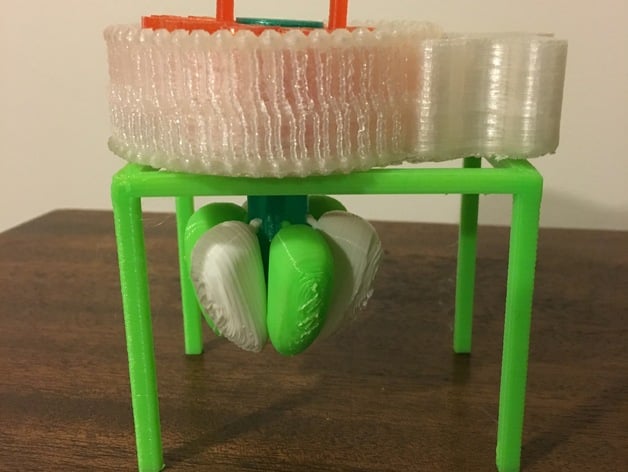
ATP Synthase
thingiverse
This 3D model lets students explore how a proton concentration gradient stores energy in the form of ATP. The model simulates the rotation of a c-subunit due to the movement of protons from a protein through a hole at the top of the membrane. As each proton moves into the c-subunit, it causes the alpha and beta subunits to move, demonstrating the conformational changes necessary for ATP synthesis. A model with a fluorescently labeled actin filament demonstrates how the spinning motion of ATP synthase was discovered using this type of experiment. Da Vinci Jr.\n\ Resolution: Infill: 5%\n\ \nThe only parts that need rafts and supports are the actin filament and hydrogen ions, which require rafts for stable adhesion and supports to maintain their structure. Other models can be printed without rafts or supports. Post-Printing:\ Step 1: Align tabs at bottom of membrane with outer column.\n\ \n Step 2: Insert alpha/beta subunits into the slots on outer column, then rotate vertically. \n\ Step 3: Insert axel into c-subunit and align with top outline of subunit.\n\ Step 4: Insert axel into outer column and align bump with column's top outline. Step 5: Assemble actin filament by attaching columns to the model using small openings. \nOverview and Background:\ This lesson focuses on the structure-function relationship of biological molecules, especially proteins. ATP synthase, an enzyme in mitochondria that stores energy in the form of ATP, is key to cellular respiration's understanding. In a cell, it plays an important part, helping to make ATP through a process known as electron transport chains. Before the activity, students should know about protein structures and cellular processes like ions' movement and concentration changes.\ The small balls used represent protons and are concentrated on the top of membrane or near it; this demonstrates how energy in ion concentrations works in relation to cells. Now you're ready for your science class! You now know the correct answer: What happens when there is more than enough protons (positive ions) stored at one side of a membrane? Materials:\ There are no extra supplies besides the model that need to be used during the activities described. The final outcome: By demonstrating how a spinning motion causes the production of ATP through its process in a concentration gradient, you've demonstrated that your scientific curiosity can be both educational and exciting at once. Project: Cellular Energetic Machinery Learning Objectives:\ - Identify where chemical energy from ATP is stored. \n\ - Be able to name parts that make up an ATP molecule\n\ - Explain the body creates chemical energy.\n By doing so, they have made some major headway in terms of being an important source of information and assistance.
With this file you will be able to print ATP Synthase with your 3D printer. Click on the button and save the file on your computer to work, edit or customize your design. You can also find more 3D designs for printers on ATP Synthase.
